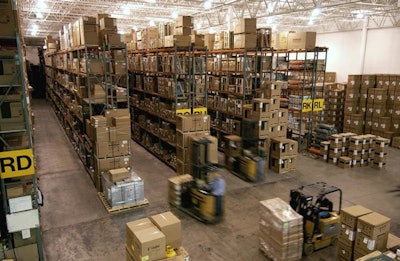
This is the third of a three-part series on thought leadership, titled, "Accelerating Fulfillment: What is your strategy for speed?" by Helgi Thor Leja, Industrial Distribution Leader, and Kim Zminkowski, Marketing Manager at Fortna Inc. "Part 1: Overall Business" can be viewed here, and "Part 2: Distribution" can be viewed here.
There are three levels of your strategy at which to consider the influence of speed:
- Overall Business Strategy (What are the requirements around speed?)
- Distribution Strategy (Where can you reduce time in transportation, inventory and other strategies that influence distribution?)
- Distribution Center Strategy (How do you speed up fulfillment within the four walls of the DC without losing accuracy and increasing cost?)
Distribution Center Strategy (inside the 4 walls)
When you know that speed is the service edge you need to enable your business and you have the strategies in place to support it, then it’s time to look at the ways you can speed up fulfillment within the four walls of the DC. You want to look at work content, wasted time, and opportunities for lean practices to reduce the amount of time between receipt of orders and shipping.
Within the DC, the goal has always been to reduce processing time. These are the basic principles of lean: less travel + fewer touches = less cost. But to speed up fulfillment, you may actually have to add “good touches” to your processes. An example of a good touch might be parallel processing (e.g., a zone pick or pick and consolidate) to reduce overall cycle time. This reduces the time it takes orders to travel across zones and can reduce cycle time considerably.
Depending on the channel, you may need different approaches. If you are trying to speed up shipments to branches, you typically look at technology-based solutions (systems to batch pick better, print and apply, etc.) that will make the operation more productive and yield speed benefits. But there are times when a manual process is the fastest way. For example, an eCommerce operation often requires more manual processing because of higher peak throughput. In this case, the fastest way is through simple systems that can handle high volume, not systems and equipment that have throughput constraints. Automation technologies such as sortation and print and apply fix speed at a certain rate, which may not allow you the flexibility to meet demand during peak times. Or then again, those solutions may be the only way to meet your demand during peak.
Questions to Ask About DC Strategy
- Where are the tradeoffs between speed and productivity? Sometimes speed and productivity are linked, but other times they work against each other. There are some things you can implement to get productivity, but not necessarily speed. For example, using print and apply technology to label cartons doesn’t mean you will get them out faster, just that you won’t need as much labor. To process orders faster, you might simply apply more labor to get it out faster than a single print and apply line. To get 30-minute order turn, you may need to have twice as many associates parallel picking than if they had longer time to fill orders and a highly efficient batch-pick process.
- What are the upstream processes that impact speed? Upstream processes like order processing, credit check, and order release all factor into overall order-to-deliver cycle. Look for ways you can speed up those processes through systems. Can you systemically release orders based on customer requirements (e.g., free shipping orders released later than orders with a next-day service requirement)? Can Merchandising share information about product sets and coordinates so that items that are likely to be ordered together are slotted together in the DC, reducing travel time?
- What is the true cost of speed? When calculating the true cost of speed, you must consider inbound cost, inside the four-walls cost and delivery cost to come up with a comprehensive picture. In some cases, speed makes sense for some parts of the business and not others. Where you have a broad array of different SKU characteristics, it may help to identify the cost at the department and/or category level which can drive decisions around speed too. Guaranteed next-day delivery will have more margin impact on planned purchases vs. the unplanned MRO items that are deemed more critical to a customer’s operations.
- Do all channels require the same level of service? Things can get quite muddy for omni-channel distributors trying to service multiple channels within the same facility. Your channels may have different service requirements. Sometimes it’s not the whole DC that needs to accelerate fulfillment. You may need multiple fulfillment engines operating at different speeds based on your channel requirements.
Do You Have a Need for Speed?
A faster cycle time operation is usually the more expensive one. But if speed is defined as a competitive advantage for your company, you may need to spend more to get that strategic advantage. Before you invest:
- Get alignment on the customers’ real service requirements, the financial benefits of faster service and constraints that impact decisions around speed.
- Perform data analysis to understand the trade-offs between cost and service. Don’t start with technologies and processes until you fully understand volume and throughput requirements, SKU velocity and affinity and seasonal peaks.
- Apply that understanding to develop a solution that meets your service requirements at optimal cost within your constraints.























